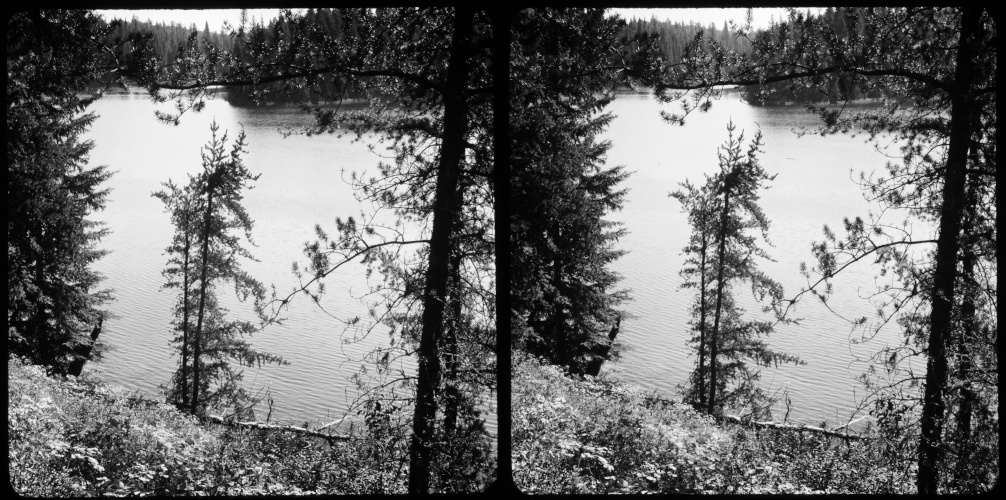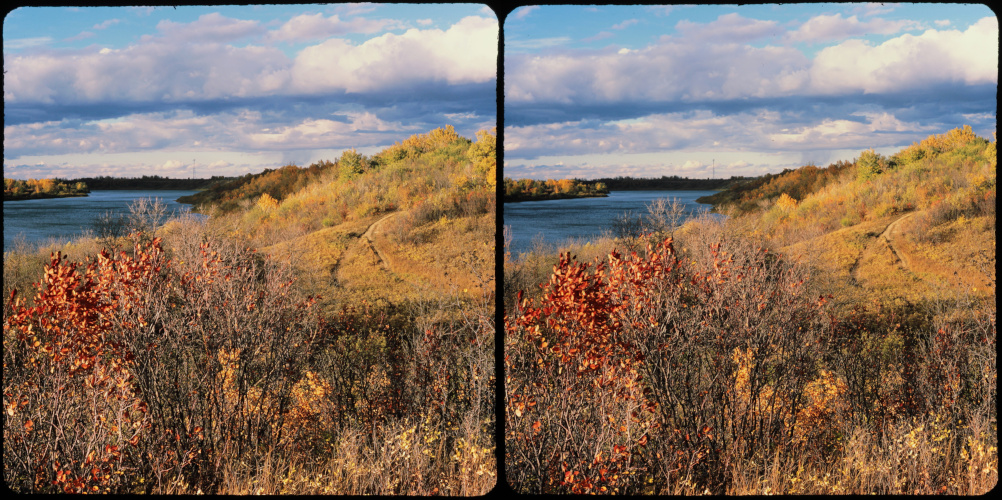Jade Lake (Narrow Hills Provincial Park, SK)

The last round I submitted a couple images I took at Narrow Hills Provincial Park, but not at this location. This is a lovely location in the North West section of the park with seven small (but very deep) lakes with very clear water. They are called the Gem Lakes, so-named for their rich blue and green colours. A network of trails runs around the lakes with several camping locations. I pitched my tent at the Diamond Lake site for two nights, which gave me a full day from dawn to dusk to photograph the area. The trails only total a length of about 6 km, so I did about 3 loops around the lakes throughout the day. This is a high spot overlooking Jade Lake. The spruce tree in the foreground is perhaps a bit gratuitous or cliche, but I thought it looked pretty and gave a good impression of what it is like to look down at the lake from the trail. The film is Delta 100, home-developed in D-67 reversal.
Meewasin Trail – Fall (Saskatoon, SK)

Meewasin Trail – Winter (Saskatoon, SK)

This is a section of trail quite near to my apartment in Saskatoon. It’s not the most remarkable location, but due to its proximity, I do get the opportunity to photograph it a lot (although I haven’t been recently). It’s the location I go to when there is some interesting light from a clearing storm or when there is hoarfrost in the winter before it gets blown off in the wind. The power plant and waste water treatment plant discharge into the river about 15 km upriver, so this section never completely freezes over. I thought the two images contrast each other nicely, although perhaps it’s a bit too repetitive since they are both taken from nearly the same perspective.
Tundra Swan (Wascana Waterfowl Park, Regina, SK)

In my hometown of Regina, there is a bird sanctuary beside the creek. There are some “display ponds”, but the grounds are really not that attractive. Although the birds are not captive, they are not easily frightened since they are used to being fed. In the shade it was rather dim using ISO 100 film, and I really was at the limit of what I could manage in terms of exposure. Handheld Tl120, not sure of the exposure settings, perhaps 1/60 and f/8. The shutter speed wasn’t enough to freeze the swan. There wasn’t enough DOF to cover the background or the foreground, but it wasn’t particularly interesting, so I just cropped it out. Next time I’ll hopefully have a flash with me, or maybe I’ll consider pushing Provia. I enjoy viewing these type of “action shots”, but I find them very challenging to take!
The first two images I have submitted were taken last summer at a unique location here in Saskatchewan called the Beechy Sand Castle and Sunken Hill. There are a couple of quarter sections of ranch land near the inlet of Lake Diefenbaker on the south Saskatchewan river that are home to some interesting land formations. It’s on private land, but the owner is gracious enough to allow visitors to come and hike around the area. Legend has it that an underground gas pocket collapsed, causing the land to give way. One day, the rancher went to check his cattle, and the tracks left by his truck a few days prior led right into the crater of the Sunken Hill!
The location is only accessible during dry conditions, since you have to drive through a field to get there. It was very hot the day I went and also quite smoky from forest fires out west in British Columbia. After walking around a bit and seeing the lay of the land, I knew I wanted to try out some hypers, but I had neither a laser rangefinder, nor Mike Davis’ stereobase calculator. I tried some anyway, but as you can see by my slipshod cutting to expand a panoramic mount, I didn’t get it quite right. Most of the hypers I took had very distracting retinal rivalry in the water, but this one didn’t seem quite as off-putting for whatever reason. This summer I have a goal to get a working system for hypers using two Agfa Isolettes.
The other two slides are from my city, Saskatoon, on one of the few days of the year that we get hoarfrost. It’s always so beautiful and it’s one of my favourite things to photograph in MF3D. I titled the one slide “Smell the Roses”, because the frost can make even a pile of overgrown weeds in an industrial district look pretty, and it seems like many people don’t stop to take notice.
Now that I’ve got a workable B&W reversal process, I’m more motivated to shoot black and white. Hope you enjoy!
Before I forget, thanks to Steven Lederman for scanning these pictures for me! I think this was Delta 100 and processed by DR5.
This picture was taken on the chikanishing trail. Spoiler for me is the right image has a reflection or something that once you see it (sorry!) it becomes very distracting.
I wonder if it’s possible to touch up the emulsion to fix this….
Talk about harsh lighting! I think this went around in the IMF3D folio. Some people liked it, some people really didn’t like it. This was taken with my Spud a long long time ago.
Taken with the TL-120 in Pennsylvania on a camping trip with James Mutch. There are a lot of waterfalls in a small area here. At one waterfall J and I watched a pro photographer taking a classic fall colour waterfall shot. His assistant held a maple branch with red leaves in front of the camera while he took pictures.
Taken with a TL-120 on the same trip to Vancouver a few years back. At that time I posted a picture of my nephew on his roller skates. I’m hoping this is a new image to this folio.
The work of Jon Hoggatt of Denton, Texas